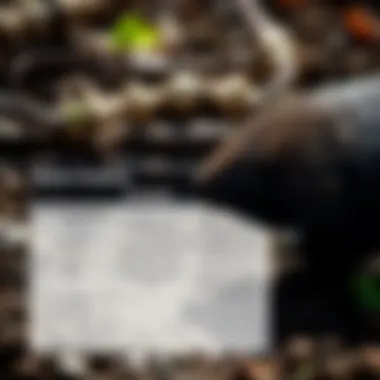Comprehensive Guide to Effective Mole Extermination


Intro
Moles inhabit a curious space in our gardens. While many see them as mere nuisances, others find them intriguing due to their underground habits and unique lifestyle. However, when moles move into your yard, they can wreak havoc on your landscaping. Understanding how to identify these elusive creatures and manage their presence effectively is essential for anyone looking to maintain a beautiful outdoor space.
This guide aims to equip homeowners, DIY enthusiasts, and pest control professionals with a comprehensive understanding of mole extermination. From understanding their biology and behavior to exploring preventive measures and treatment options, we'll delve into practical strategies for managing mole infestations. We’ll also clear the air regarding misconceptions that often swirl around these creatures, helping you differentiate fact from fiction.
With a myriad of approaches available, it’s vital to choose the right methods for your unique situation. Moles, while well adapted to a life beneath the ground, can still be effectively managed without resorting to harsh tactics that may endanger the ecosystem around your home. Let’s start our journey by identifying these little critters and understanding their role in our gardens.
Understanding Moles
Understanding the intricacies of moles is vital for anyone dealing with their presence, especially homeowners who find their gardens disrupted. Knowing about the various mole species, their behaviors, and the signs that indicate an infestation can save time, money, and significant stress. Effective mole management starts with appreciating what these creatures are and how they operate.
Overview of Mole Species
Moles belong to the family Talpidae and are primarily adapted to a subterranean lifestyle. The most common species found in North America are the Eastern mole, the Star-nosed mole, and the Townsend's mole. Each of these species possesses unique traits:
- Eastern Mole: Recognized for its velvety fur and large front paws, it thrives in a variety of habitats from lawns to gardens.
- Star-nosed Mole: Famous for its distinctive nose, it prefers wetland areas and is often found near the water.
- Townsend's Mole: This one has a more compact body and is usually found in regions with rich, moist soil.
Knowing which species you're up against can help you tailor your approach to prevention and extermination. It's not just about getting rid of them; it's about understanding their habits and making your space as uninviting as possible.
Mole Behavior and Habitats
Moles are predominantly nocturnal, exhibiting behaviors that are mostly subterranean. They dig complex tunnel systems in search of earthworms, insects, and roots. These burrows can be extensive, sometimes measuring over 100 feet in length within a single night. Common habitats include:
- Lawns: Moles adore moist, rich soil, making well-kept gardens prime territory.
- Woodlands: Areas with a mix of trees and open spaces give them the cover they need while they hunt.
- Fields: Agricultural lands are frequently at risk, as moles can affect crop health significantly.
Understanding their preferred habitats can help homeowners spot potential issues before a full infestation occurs, allowing for timely interventions.
Signs of a Mole Infestation
Detecting a mole intrusion can be tricky, especially since these creatures are elusive. However, some telltale signs can alert homeowners to their presence:
- Molehills: Small mounds of dirt that appear on the surface are classic indicators. These are created when moles push dirt up while tunneling.
- Surface Tunnels: Raised ridges in lawn areas indicate active surface tunnels. When you walk on these, they can collapse easily, signaling mole activity.
- Plant Damage: If plants are wilting, particularly if they seem to have been uprooted or heaved from below, moles might be the culprits.
Keeping an eye out for these signs can save you a world of trouble down the line.
Recognizing these indicators promptly can lead to effective management strategies, ensuring the beauty and health of your garden or lawn remains intact.
The Impact of Moles
Understanding the impact that moles have on our environment and daily lives is fundamental in addressing any issues they may cause. While often viewed with a critical eye due to their tunneling habits, moles can play a vital role in local ecosystems. Grasping both their beneficial and detrimental contributions enables homeowners to approach infestation problems with a well-rounded perspective.
Ecological Role of Moles
Moles may often seem like a nuisance, but they are essential players in the ecosystem. They aerate the soil through their tunneling, which helps improve water infiltration and increases nutrient availability for plants. This natural tilling effect enhances the overall health of gardens and lawns.
Additionally, moles are insectivores, which means they help control populations of insects and other pests. For instance, by consuming grubs, which are larvae of beetles known to damage turfgrass, moles can actually reduce the damage that these pests can do. This, in turn, minimizes the need for chemical pesticides, creating a more sustainable gardening approach.
Moles contribute to a balance in soil health, pest control, and plant growth, making them unsung heroes underneath our feet.
Damage to Gardens and Lawns
However, the other side of the coin is the damage that moles can inflict. Their tunneling activities often lead to uprooted plants, unsightly mounds of dirt, and surface disruptions that can impact the aesthetic of lawns and gardens. While the roots of established plants may still survive, the superficial disturbances can make a garden look unkempt.
Common indicators of mole activity include:
- Raised, ridged pathways in lawns
- Fresh earth mounds appearing overnight
- Uprooted plants or wilting vegetation due to root damage
The effect on lawns can sometimes extend beyond visual aesthetics. Compacted soil from tunneling may lead to poor drainage, creating unhealthy conditions for grass and other plants to thrive.
Consequences for Pest Control
Adequately managing moles is crucial for effective pest control. On one hand, moles keep certain pest populations in check; on the other, their presence might also create a dual challenge. For instance, moles may inadvertently disturb the habitat of other pervasive pests, such as voles or insects, leading to an increased population of these creatures. The chaos can escalate into a cycle where one problem leads to another.
Consequently, homeowners must be astute in recognizing the balance of advantages and disadvantages that moles represent. Becoming informed about their behaviors and habitats will assist in making educated decisions on whether to manage them through extermination or employ methods that simply manipulate their activity without elimination.
Considerations include:
- Assessing whether the benefits of mole activity outweigh the immediate drawbacks in your specific garden or lawn scenario.
- Implementing preventive measures that reduce their presence without resorting to lethal methods, which often leads to further ecological repercussions.
In summary, moles possess a complex role in our gardens and lawns, contributing positively through aeration and pest control while also presenting challenges that can't be disregarded. A nuanced understanding of their impact can serve as an effective starting point for any homeowner facing mole-related dilemmas.
Assessment of Mole Problems
Understanding how to assess mole problems is crucial for any homeowner dealing with yard disturbances due to these small critters. Accurately identifying damage and evaluating the severity of the infestation can make all the difference in choosing the right method for extermination. Not only does effective assessment help in prioritizing action but it also aids in minimizing further harm to your lawn and garden. Ultimately, recognizing these issues early can save money and time down the road, ensuring a healthier environment for both plants and people.
Identifying Mole Damage
When you first suspect a mole issue, it’s important to pinpoint any damage they may have caused. Moles usually create surface tunnels that can be an eyesore for homeowners. These mounds of soil are often scattered throughout the garden, which may look like small volcanoes rising up from the earth.
Some key indicators include:
- Raised soil mounds: These are piles that result from moles relocating earth from their tunnels.
- Indents in plants: Plants may be pushed over due to the displacement of soil underground.
- Uneven lawn surfaces: Tunnels can create dips and bumps, leading to an unsightly yard appearance.
Make a round in your yard and look for these signs. If you observe multiple mounds or signs of destruction near plants, it’s a clear signal that moles are active. Taking the time to mark these areas can ease the process of control later on.
Evaluating Infestation Severity
Once you identify the damage, the next step involves evaluating how serious the mole problem is. Severity will often dictate your approach to extermination. Here’s how to determine the level of infestation:
- Frequency of sightings: If you spot a mole frequently moving across your yard, the problem is likely substantive.
- Extent of damage: A few mounds could be a random occurrence, but an extensive network of tunnels indicates a larger population at work.
- Duration of activity: If the signs have been present for several weeks or more, it signals a deeper-rooted issue.


Consider taking note of:
- The size of the area affected.
- How quickly mounds or tunnels reappear after filling them in.
This approach not only helps gauge the immediacy of action required but also assists in implementing the most effective response based on how extensive the issue has become.
In summary, assessing mole problems involves a mix of observation and logical evaluation. By keenly observing signs of mole activities and taking time to understand the severity of the infestation, homeowners can choose the right tactics to manage these small but impactful creatures.
Key Takeaway: Early detection of mole damage allows for timely action, ultimately leading to effective solutions and a healthier yard.
For more insightful strategies, consider visiting resources like Wikipedia, or engaging with the community on Reddit.
Prevention Strategies
When it comes to dealing with moles, prevention is often cheaper and more effective than trying to exterminate them once they've established a presence. Understanding how to protect your lawn and garden is crucial for any homeowner who wishes to keep these burrowing nuisances at bay. Diligent prevention strategies not only save time and money in the long run but also create a more sustainable living environment. Let's explore some effective ways to minimize the chances of a mole infestation.
Landscaping Techniques
Taking a proactive approach to landscaping can significantly deter moles from making their home in your yard. Here are several techniques to consider:
- Use of Raised Beds: Creating raised garden beds elevates your plants above ground level. Moles may feel less inclined to tunnel through well-maintained beds, as their underground pathways can be disrupted by the change in soil elevation.
- Plant Selection: Some plants are less appealing to moles due to their strong scents or root systems. Consider planting daffodils and crown imperials, for instance, both of which are known to repel moles. Additionally, introducing ground cover plants might help keep the soil compact, making it tougher for moles to dig.
- Soil Management: Ensuring healthy soil with a balanced pH can help keep the ecosystem around your garden thriving while also discouraging moles. Compacted or overly moist soil creates a welcoming environment for moles. Aeration of the soil using a garden fork or specialized tools can discourage moles from creating an extensive network of tunnels.
Implementing these landscaping techniques can be an effective first line of defense against mole invasions.
Natural Deterrents
Beyond landscaping, nature provides various deterrents that can help keep moles away. A few commonly used natural options are:
- Essential Oils: Moles are sensitive to strong odors. Applying essential oils such as peppermint or castor oil can drive them away. Mixing these oils with water and spraying them around your garden can produce an aromatic barrier that moles find unpleasant.
- Vibrational Devices: Some devices claim to deter moles by emitting vibrations underground. They tend to have varying success, and while we can’t guarantee results, their low-maintenance nature makes them worth a shot as a natural solution.
- Companion Planting: Introducing plants such as marigolds near your vegetable garden can fend off moles. The root systems and scents produced from certain plants can make the area less attractive to them, giving your preferred plants a fighting chance.
These natural deterrents can be gentle yet effective methods to dissuade moles without causing any harm to the local ecosystem.
Homeowner Practices
In addition to proactive landscaping and natural deterrents, there are several practices that homeowners can adopt to prevent mole activities. Here’s what you can do:
- Regular Maintenance: Make a point to keep your yard well-maintained. Regularly mowing the lawn, raking leaves, and removing excess debris creates a less favorable environment for moles. A tidy yard is less likely to attract insects, which are the main food source for moles.
- Dietary Control: If you have pets, be sure to monitor their food sources outside. Unattended pet food can attract various rodents, indirectly attracting moles as well. By managing these food sources, you can help reduce the local rodent population.
- Composting Wisely: While compost heaps are excellent for enriching soil, they can also be a food source for moles. Make sure compost piles are kept tidy and monitor them regularly to avoid attracting unwanted guests.
By embracing these homeowner practices, you can create an unwelcoming atmosphere for moles and minimize the chances of an infestation.
Methods of Mole Extermination
When dealing with an issue as persistent as a mole infestation, understanding the variety of extermination methods is crucial. Methods of mole extermination are not merely about eliminating the problem but doing so effectively and humanely. Each technique comes with its own set of advantages and considerations which can help a homeowner decide the best path forward to restore peace in their lawns and gardens.
Trapping Methods
Trapping is often considered one of the most effective ways to rid your property of moles. These creatures are remarkably elusive, making traps a preferred choice. Here’s why trapping may just be your best bet:
- Immediate Results: Traps can provide instant results. Once set up correctly, you could eliminate a mole within a short period.
- No Chemicals: If you’re wary of chemical solutions, traps offer a method that doesn’t introduce harmful substances to your soil or surrounding plants.
Common types of traps include:
- Scissor Traps: These are spring-loaded traps that mimic the action of a guillotine. They're quite effective when bold enough, catching moles quickly.
- Box Traps: These traps are designed to catch moles that wander into them unwittingly. They’re set within a tunnel and can capture multiple moles over time.
- Nail Traps: A less conventional method, nail traps can be effective in some situations, but they require careful handling to avoid harm to non-target animals.
Key Considerations:
- Placement is King: Placing traps right where you notice the most activity—indicators like fresh tunnels—will improve your chances of success.
- Timing: Early morning or late evening is when moles are most active, making these times optimal for checking and setting your traps.
Chemical Solutions
Chemical eradication might appear as a quick fix for homeowners, but it calls for discretion and knowledge. Here’s how these solutions work:
- Toxic Baits: These baits attract moles with appealing ingredients and deliver a lethal dose. Though effective, they raise safety concerns for pets and other wildlife.
- Soil Insecticides: Certain insecticides aim to disrupt the worms and grubs that moles feed on, effectively eliminating their food source and encouraging them to vacate the area.
Some common products used include:
- Zinc Phosphide: This is an active ingredient in many mole baits, where caution is paramount. Ensure it is applied in accordance with local regulations.
- Sodium Nitrate: Often used in baits targeting moles, it's crucial to handle this chemical carefully due to its risks.
Important Note: Chemical solutions should always be used as a last resort, ensuring compliance with local environmental laws. Check resources such as EPA for regulations.
Ultrasonic Devices
Ultrasonic devices offer a modern approach to mole control that’s gaining popularity among environmentally-conscious homeowners. Here’s what you need to know:
- How They Work: These devices emit sound waves that are inaudible to humans but supposedly disrupt moles' activities. The theory is that the noises will drive moles away from your yard without causing them harm.
- Benefits: They are non-toxic and easy to use. Simply place them in the ground, and you’re good to go.
- Limitations: While some users report success, scientific evidence backing their effectiveness is still somewhat sparse. It’s vital to manage expectations to avoid disappointment.
In sum, it’s essential to understand that no one-size-fits-all approach exists for mole extermination. The method you choose hinges on your specific situation, preferences, and ethical considerations. Collectively, these approaches equip homeowners with tools to reclaim their outdoor spaces and mitigate the hassle of unwanted mole guests.
Trapping Techniques Explained
When it comes to managing mole infestations, trapping serves as one of the most effective and humane methods available. This section peeles back the layers on various aspects of trapping, helping homeowners navigate through the numerous options tailored to their needs. The beauty of trapping lies in its dual capability to eliminate unwanted moles while safeguarding the surrounding environment from potentially harmful chemicals. It's a practical solution that allows individuals to take charge of their backyard terrain.
Types of Traps
Traps designed for moles come in a handful of main varieties, each with its unique mechanisms. Here are a few notable types:
- Scissor Traps: Resembling a giant pair of scissors, these traps are spring-loaded and designed to snap shut when triggered. They are ideal for use in active tunnels.
- Harpoon Traps: This type features a pointed spear that impales the mole upon activation. They can be very effective but require proper placement and patience, as they can trigger easily if not set right.
- Tunnel Traps: These traps are placed in the ground where moles travel. They catch moles as they move through the paths they have already carved.
- Pitfall Traps: Although more labor-intensive, these traps involve digging a pit and using a bait to lure moles into it. However, this method tends to require more work and regular inspection.
Choosing the right trap often depends on the specific characteristics of the mole population in your area, as well as the individual’s level of comfort with complex trapping systems.
Trap Placement and Timing
Once the right type of trap has been selected, the next critical step is proper placement and timing. Positioning traps in the right locations can significantly increase your chances of a successful capture. Here are key considerations:


- Identifying Active Tunnels: Look for molehills and raised ridges that indicate a busy pathway. Actively used tunnels appear soft and easy to collapse when pressed down. Placing traps in these areas can help catch moles effectively.
- Optimal Timing: The best time for trapping is usually in the spring and fall; during these seasons, moles are more active, making it more likely that your traps will catch them.
- Depth of Placement: Ensure traps are set at the proper depth in the tunnel. They should be positioned underground to avoid light, as moles tend to shy away from bright areas.
Getting these elements correct is akin to hitting the nail on the head, maximizing success rates and minimizing effort.
Effective Baiting Methods
While many traps operate effectively without bait, a touch of bait can often elevate the trap's performance. Here's how you can make sure your baiting methods are on point:
- Choosing the Right Bait: Earthworms make an excellent bait option. They are a favorite among moles and can easily be sourced from local gardens or garden centers. Another option is to use peanut butter on a small piece of bread, as it can entice moles to investigate further.
- Bait Placement: When baiting, position it in front of the trap and within the active tunnel. This can encourage the mole to move towards the trap.
- Freshness is Key: Always replace bait and keep it fresh; stagnant or spoiled bait can deter moles from approaching.
By adhering to these baiting techniques, you'll significantly boost your trapping effectiveness, ensuring even the trickiest of moles fall for your bait.
"Setting traps is an art and a science; understanding mole behavior can turn the odds in your favor."
Chemical Control Options
Chemical control options are a crucial aspect of managing mole populations effectively. While it might not be the first line of defense, understanding how and when to use various chemical agents can make a significant difference in your strategy against these burrowing nuisances. It’s essential to consider that improper use can lead to environmental hazards and potential harm to non-target species, thus taking a measured approach is paramount.
In this section, we will delve into the types of chemicals available, the best methods to apply them, and what safety measures should be in place when handling these substances.
Types of Chemicals Used
When it comes to chemicals for mole control, there are a few different categories worth discussing:
- Synthetic Rodenticides: These are chemical substances designed specifically for killing rodents, including moles. They work by interfering with the mole's metabolism, leading to a fatal outcome. While effective, one must exercise caution due to their toxicity to non-target animals too.
- Repellents: Often used as preventative measures, these chemicals make the ground less hospitable for moles. They can often be found in a liquid form that can be sprayed onto the soil to deter moles from inhabiting certain areas.
- Fumigants: These are gases utilized in underground settings. The aim is to eliminate moles by filling their tunnels with a lethal gas. This method requires thorough knowledge of both the chemical properties and the mole’s habits to be successful.
"Always consider the long-term impact of chemical usage on local wildlife and the soil. \n Responsible application is key to sustainable pest management."
Application Techniques
Using chemical agents to control moles is not as straightforward as it seems. Here are some application techniques that can maximize effectiveness:
- Targeted Placement: Place chemical agents directly into the tunnels. This minimizes exposure to non-target species and enhances the likelihood of encountering a mole.
- Timing: Apply products during late evening or early morning hours when moles are most active. These periods increase the chances of moles interacting with the treatment.
- Follow Instructions: Always read and adhere to the manufacturer’s guidelines. This includes knowing how much product to use, how frequently it should be applied, and how it should be handled.
Safety Considerations
When utilizing chemical control options, ensuring your safety and that of the environment should be a top priority. Here are a few safety considerations:
- Read Labels Carefully: Before using any chemical product, make sure to read labels thoroughly. They provide vital information on toxicity levels and how to handle the substance.
- Protective Gear: It’s prudent to wear gloves and possibly a mask when handling chemicals to avoid skin or respiratory irritation.
- Child and Pet Safety: Keep children and pets away from treated areas until it’s safe. Many chemicals pose serious hazards to both humans and animals.
- Environmental Impact: Be mindful of local wildlife and plants. Certain chemicals might significantly disrupt local ecosystems. Research alternative, eco-friendlier options if conventional methods pose a high risk.
For further information and research resources, you might check out links like the CDC or National Pesticide Information Retrieval System, where government guidelines and safety resources are available.
Using Ultrasonic Devices
Using ultrasonic devices for mole extermination has gained traction in recent years, largely due to shifts in preferences towards environmentally-friendly pest control methods. These devices generate high-frequency sound waves which are inaudible to humans but can be distressing for moles. The goal is to create an unfavorable habitat for these critters, encouraging them to relocate without the lethal measures that many traditional methods entail. For households looking to manage their gardens or lawns without chemicals, ultrasonic technology can serve as a unique and non-invasive solution.
How Ultrasonic Devices Work
Ultrasonic devices function by emitting sound waves at a frequency typically above 20 kHz. Moles, possessing sensitive auditory systems, are sensitive to these frequencies. The sound emitted disrupts their calm behaviors, effectively sending a signal that indicates a hazardous environment.
The basic mechanics are straightforward:
- Sound Waves Creation: These devices usually contain a transducer, which generates the ultrasonic waves.
- Range of Emission: They can cover a certain radius, often around a few hundred feet, depending on the model.
- Continuous Or Intermittent Sound: Some models operate continuously, while others emit sounds in intervals, enhancing their effectiveness by simulating the presence of a threat.
Effectiveness and Limitations
While many users report success with ultrasonic devices, it is crucial to understand both their strengths and weaknesses.
Effectiveness
- Non-lethal Approach: They offer a humane solution by displacing moles rather than exterminating them.
- Minimal Maintenance: Most devices require little in terms of upkeep; once installed, they often run on batteries or solar energy.
- Increased Garden Protection: When used as part of a broader pest control strategy, they can enhance the garden’s defense system.
Limitations
- Variable Results: Responses from moles can vary significantly; some may be deterred, while others remain unbothered.
- Habitat Suitability: Ultrasonic waves might not spread effectively in wet soil or dense vegetation, sometimes limiting the device’s influence.
- Need for Utilization: For best results, homeowners should ideally deploy these devices in tandem with additional pest control efforts, such as barriers or traps.
Moles remain persistent creatures, and while ultrasonic devices can contribute to a robust strategy, they are not a standalone solution.
For more information about trapping and managing pest problems, consider reviewing resources at National Pest Management Association or local extension services available at USDA.
Legal and Ethical Considerations
Addressing mole infestations goes beyond mere methods and strategies. It also necessitates an understanding of the legal and ethical frameworks guiding extermination practices. Not recognizing these facets can not only lead to regulatory pitfalls but may also reflect poorly on the conscientious efforts of homeowners or pest control professionals. Knowing the rules can save headaches down the road and ensure that both people and wildlife are treated with respect.
Local Regulations on Extermination
When it comes to local regulations regarding mole extermination, it’s crucial to do your homework. Different regions have varying laws on how and when you can deal with these critters. Some areas might consider moles game animals, while others may deem them as pests. In some states, killing moles might require a permit or follow specific methods to ensure compliance with wildlife management laws.
- Check Local Wildlife Regulations: Look up your state’s wildlife agency to understand the guidelines that dictate how moles can be controlled.
- Permits and Licenses: In certain jurisdictions, pest control companies need specific licenses to operate legally. Always ask if they possess the necessary permissions.
- Endangered Species Considerations: Sometimes, native species may be protected. Educate yourself on the species in your area to avoid inadvertently breaking the law.
Consulting with local pest control services can also help you navigate the legal landscape while achieving a solution to your mole problem.
“Understanding local regulations preserves the delicate balance between effective pest management and protecting native wildlife.”
Humane Treatment of Moles
The ethical treatment of moles is not just an option but an obligation for anyone engaged in pest control. While dealing with moles, it is vital to approach their extermination in a humane manner. These creatures, though often considered nuisances, play an essential role in the ecosystem by aerating soil and controlling insect populations.
Here are a few humane strategies to consider:
- Live Trapping: Using traps that capture moles alive allows for relocation instead of death. This method is respectful of wildlife and complies with many local regulations.
- Non-lethal Deterrents: Utilizing natural deterrents can be effective while minimizing harm. Spreading castor oil or plant-based repellents tends to restrict moles without causing them harm.
- Education and Awareness: Sometimes, educating neighbors about the ecological benefits of having moles can result in community support for humane practices.


By treating moles humanely, not only do you comply with ethical standards, but you also contribute to a healthier ecosystem, showcasing responsibility and integrity in pest management methods.
In sum, understanding local regulations and engaging in humane practices ensures not just successful mole control, but also upholds the delicate balance of nature. The guiding principle should always be achieving solutions that are effective, legal, and ethical.
When to Call a Professional
In the world of mole control, knowing when to hand the reins over to a professional pest control service can save both time and headache. Many homeowners may feel that handling a mole issue themselves is manageable, but there are essential elements to consider that might well tip the scales towards inviting a professional into the fold.
Beyond mere annoyance, a significant mole infestation can lead to a cascade of complications, from severely damaged lawns and gardens to underground burrows compromising the integrity of structures or other plants.
Determining the right moment to ring in the experts involves weighing several factors:
- Extent of Damage: If your garden or landscape resembles a war zone after a mole foray, with mounds of dirt strewn about, it’s probably time to seek professional help.
- Number of Moles: Identifying a single mole can be sufficient for a DIY approach, but if you suspect multiple moles operating in your yard like an underground army, getting expert advice is a wise move.
- Repeated Attempts Failed: If traps and natural deterrents seem to bounce off the moles like water off a duck’s back, it might be time to accept defeat and hand things over to someone who knows the lay of the land.
As many say, "better safe than sorry." Not only will a pro know the ins and outs of effective mole removal, but they also can provide ongoing advice for preventing future issues. With all that in mind, let's explore how to assess the magnitude of a mole problem properly.
Assessing Problem Magnitude
To tackle your mole issue prudently, first, you need to assess just how significant the problem is. Some homeowners might comb through their yards, scratching their heads at small hills and the occasional trail that has raided their garden space. However, an everyday nuisance could spiral into a more severe infestation if not dealt with timely.
Start by examining the following points:
- Inspect for Active Signs: Take a closer look at the soil. Freshly disturbed soil tends to look darker and softer. Active mounds, punctuated by those characteristically raised dirt piles, indicate ongoing activity.
- Count the Mounds: One or two mounds can indicate an isolated issue, but a dozen or more could be the start of a mole city. If the number of mounds seems overwhelming, this usually marks a pressing need for professional intervention.
- Evaluate Landscape Damage: Look for tunneling damage that could threaten your prized flowers or shrubs. If roots are exposed or plants appear to be wilting without clear reason, moles could be lurking below.
Answering these questions will leave you with a clearer picture of how to proceed. If the problem does indeed call for help, let’s delve into how to choose an experienced pest control service.
Selecting a Pest Control Service
Choosing the right pest control service isn't merely a matter of flipping through a phone book. The stakes are high when dealing with a creature as crafty as a mole. Here’s a step-by-step to help guide you through this process:
- Research Local Providers: Look online for pest control companies within your local area. Check out their websites and read reviews on platforms like Yelp or local Facebook groups. Don’t underestimate word-of-mouth referrals from neighbors.
- Inquire About Expertise: Not every pest control service has extensive experience with moles, believe it or not. When you contact them, ensure they have a solid grasp of mole biology, behavior, and effective tactics for removal.
- Ask for Certifications: Licensed and insured services are always a safer bet. This not only covers them but protects you as well.
- Compare Quotes: Once you've narrowed down your list, it's prudent to get estimates. Don’t just go for the cheapest option—a pricey service without knowledge won't help either.
- Understand Their Approach: Inquire about their extermination methods. Particularly, check out their stance on humane treatment of wildlife. A conscientious company will have humane options alongside standard extermination methods.
"Choosing a knowledgeable pest control service can turn your mole disaster into a breeze."
Following these steps, you'll be positioned well to select a pest control service that not only addresses your current mole issues but also keeps your lawn and garden free of future trouble.
With proper assessment and a reliable pest control partner, you'll be on the road to reclaiming your yard from those pesky moles.
Post-Extermination Practices
After dealing with mole infestations, it’s crucial for homeowners to focus on post-extermination practices. This phase not only addresses the damages moles may have caused but also helps in preventing future invasions. Knowledge of what to do next is just as important as removing the moles themselves. Here, we’ll delve into two essential aspects of post-extermination practices: monitoring for reinfestation and restoring damaged areas.
Monitoring for Reinfestation
Once you have rid your property of moles, the work doesn’t just stop there. Monitoring for reinfestation should become a priority. Moles are persistent creatures, and if your yard is conducive to their habitat, they might be back before you can blink.
- Regular Inspection: Take time to examine your yard regularly. Look for new molehills or tunnels. It might take just a few minutes each week, but catching those early signs means dealing with the problem before it escalates.
- Set Traps in Key Areas: After initial extermination, consider placing traps in areas where moles are likely to return. This could be near existing burrow systems or under the cover of your garden plants. Monitoring these traps not only prepares you for potential issues but helps in your alertness towards changes in your lawn.
- Observe Soil Conditions: If the soil in your garden feels soft and unusually spongy, it could be a sign that moles are burrowing beneath. Keep an eye out for patches of ground that seem to sink or shift unexpectedly, indicating a possible resurgence of the problem.
By staying vigilant and inspecting regularly, you increase the odds of catching new intruders before they can cause any significant damage.
Restoring Damaged Areas
After the extermination process, most yards will bear the scars of mole activity. These disturbances not only affect the aesthetic appeal but can also complicate the health of your garden’s soil. Here are some focused strategies to restore your property post-extermination:
- Fill in Holes and Tunnels: Begin by addressing the visible signs of mole activity. Using topsoil or compost, fill in the holes and flatten any raised earth. This can ease any uneven settling that can hinder your lawn's growth and overall appearance.
- Reseed or Reseed: If your lawn has been heavily impacted, reseeding patches can ensure that your grass returns thick and healthy. Choose a grass type that suits your climate conditions, and make sure to keep the soil moist until the seeds germinate. Meanwhile, sowing wildflowers in areas not utilized may add a splash of color and help attract beneficial insects.
- Enhance Soil Health: The damage done by moles can sometimes lead to soil compaction. Aerating your lawn can help restore proper drainage and improve nutrient penetration. Consider mixing organic compost into your topsoil to enrich it, creating a more hospitable environment for future plants.
- Regular Maintenance: Once your lawn is restored, adopt a routine for its care. Regular watering, mowing at an appropriate height, and fertilizing will strengthen the grass and overall soil. Healthy grass will be less susceptible to pests and weeds, contributing to fewer issues in the future.
Remember, a healthy lawn is one of your best defenses against reinfestation.
By monitoring for reinfestation and restoring damaged areas diligently, homeowners can not only secure their lawns against future mole issues but also encourage a thriving garden ecosystem. Once the moles are gone and the damage is repaired, the focus shifts to creating a landscape that's healthy and less inviting for unwelcome visitors in the future.
Common Myths About Moles
Navigating through the plethora of misinformation surrounding moles is essential for those tackling infestations. Understanding common myths can empower homeowners in their efforts to effectively manage these creatures. By shedding light on misconceptions, we aim to equip you with clearer insights, preventing unnecessary panic or misplaced strategies in dealing with moles.
Debunking Misconceptions
Moles have long been the subject of various rumors and myths. One prevalent belief is that moles are blind. While their eyesight may not be very keen, they are certainly not blind. Their vision is adapted to low light conditions, emphasizing their reliance on other senses, such as touch and sound, to navigate their subterranean world. This misunderstanding leads many to erroneously believe that moles aren’t capable of perceiving danger, which could result in ineffective deterrent strategies.
Another common myth suggests that moles primarily destroy lawns and gardens. Yes, moles can create unsightly tunnels and hills, but their main diet consists of insects and earthworms. They actually contribute to soil aeration, benefiting gardens rather than merely harming them. Homeowners may unwittingly wage war on these creatures while they’re unwittingly enhancing the ecosystem.
Misconceptions extend further to the belief that moles are solitary animals. On the contrary, they can be social and sometimes share their burrows with other moles. This could skew the perception of the problem’s magnitude, leading homeowners to assume they are dealing with multiple infestations when it may just be single creatures moving in and out.
Understanding Their Role in Ecosystems
Moles play a crucial role in maintaining the health of the ecosystem. They aerate the soil through their tunneling, allowing water and nutrients to penetrate deeper layers. This process is essential for plant growth, contributing to robust gardens and landscapes. Homeowners may bemoan their presence due to surface disruption, but the reality is that these animals are silent workers, fostering a more fertile ground.
Furthermore, by consuming large quantities of insects, including grubs, moles help control pest populations naturally. While it might not seem like it when digging holes mars the aesthetic appeal of a lawn, the ecological benefits they provide are quite significant.
Understanding this role can shift the perspective from viewing moles as mere nuisances to recognizing their ecological contributions. To many homeowners, this knowledge can guide better management practices that focus on coexistence rather than eradication.
"Moles, with their tunneling and insect-eating habits, serve as unsung heroes in the ecosystem, ensuring balance and fertility in our gardens."
To conclude, unraveling the myths about moles is crucial for implementing effective strategies in managing them. With a proper understanding of their behavior and ecological role, homeowners can adopt a more informed approach, turning a problem into a constructive opportunity.
End
In wrapping up this comprehensive journey through the often misunderstood world of moles, it's vital to spotlight the core elements discussed throughout the article. Moles, while they might seem like mere nuisances, play a noteworthy ecological role, yet their underground activities can wreak havoc on gardens and lawns if left unchecked.
Recap of Effective Strategies
The strategies explored here are not mere quick fixes; they are nuanced approaches tailored to address the problem of mole infestations effectively. Understanding the behavior of moles lays the groundwork for effective control.
- Trapping remains the gold standard, favored for its direct approach and high efficacy. Key to success is the placement and baiting techniques, which must be executed with precision.
- Chemical solutions serve as an alternative, but they demand careful application and understanding of safety considerations. An informed approach avoids unintended consequences on the surrounding environment.
- Ultrasonic devices offer a modern twist, though their effectiveness can vary. They are worth considering as part of a broader strategy that combines various methods.
Moreover, the importance of prevention should not be understated. Cultivating an understanding of preventive measures—landscaping techniques, natural deterrents, and mindful homeowner practices—can often deter invasions before they start.
"A stitch in time saves nine"—this old adage rings especially true in combatting mole infestations.
Through this guide, homeowners have gained insights into the multifaceted strategies for managing moles. By embracing a proactive attitude and utilizing the knowledge provided, you can safeguard your outdoor spaces while maintaining respect for the ecological role of these creatures. Staying vigilant and informed, you can effectively navigate the challenges that moles present, ensuring your gardens and lawns thrive—a win-win for both nature and nurture.



